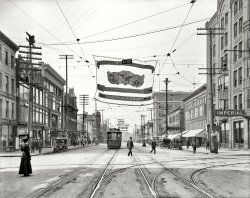
MAY CONTAIN NUTS

Search Shorpy
SHORPY ART

Framed or unframed, desk size to sofa size, printed by us in Arizona and Alabama since 2007. Explore now.
Join and Share
Ad-Free Shorpy
Shorpy is funded by you. Patreon contributors get an ad-free experience.
Learn more.

Recent comments
- Illuminate us
- I remember it well
- I can't prove it
- Complicated then, forgotten now
- Bryan-Stevenson
- Skinny is as skinny does
- How do you rest in peace
- Riding the footboards
- Alas, hidden from view
- Baldwin Diesels
- Exclusive pump
- Bananas, Oysters and Smokey Joe
- Details, Details
- What's that building to the left of the tower?
- Coal Barges
- Bromo-Seltzer
- Inner harbor
- The Basin
- What a headache!
- Giant stepladder?
- Yeah, it was cold
- Love those coats
- Link & Pin Days Remnant
- Baldwin 62303
- Baldwin VO-1000
- Cold
- No expense spared
- Tough Guys
- What's your hurry, where's your hat?
- Sheriff's Signature
Member Photos
The Shorpy
Print Emporium
Print Emporium
Search Shorpy
Search results -- 30 results per page
- Syracuse Panorama: 1901
- Syracuse, New York, circa 1901, in a panoramic view of the Erie Canal combining three 8x10 ... one on the left with the tower and long shed is the old New York Central station.
The pre-concrete Erie Canal For those not ... Posted by Dave - 07/28/2012 - 4:16pm -

- Erie Canal: 1904
- "1904. Erie Canal at Salina Street, Syracuse, New York." Detroit Publishing Company glass negative, Library of Congress. ... Behind the photographer, the canal split, the Erie to Buffalo, the Oswego Canal to, well, Oswego a port city on Lake Ontario. This ... Posted by Dave - 08/01/2012 - 1:34pm -
![Erie Canal: 1904 "1904. Erie Canal at Salina Street, Syracuse, New York." Detroit Publishing Company glass negative, Library of Congress. View full size.
Watch Yer HeadLow bridge, everybody down.
For it's low bridge,
We're coming to a town!
You can always tell your neighbor,
You can always tell your pal,
If you've ever navigated
On the Erie Canal.
-- "Low Bridge" by Thomas S. Allen
Clinton SquareLooks like this is now a large public fountain if, as it appears, this current shot is taken from almost the exact same angle.
http://www.panoramio.com/photo/12595565
(Click the photo for Shorpyesque "Hi-Def Image")
Stone GorgeousAll the elaborate stonework of the buildings along the canal makes the scene look something like Venice. Was that intentional, or not? I'd say that it was.
I once spent a summer in Venice,
And I had a yen to play tennis,
But those darn canals were a menace,
So I didn't play tennis in Venice.
-- Frank Crumit (1931)
Horse PowerIn 1904 I would have expected real horse or mule power to pull the barges but it appears there is no path on one side and, to the left, it stops. Is this a terminus or are they perhaps using coal?
Stairway to HeavenLove the stairs to nowhere. But wait! Not to nowhere. The stairs become very valuable when the bridge is up. While up, canal boats can pass underneath and pedestrians can use the stairs to cross without having to wait for the bridge to come back down. I've never seen a bridge like that.
Path to somewhereI live in Syracuse, the path on the left stops in Albany. They do have some steamers in this shot though. Behind the photographer, the canal split, the Erie to Buffalo, the Oswego Canal to, well, Oswego a port city on Lake Ontario. This scene lasted only 12 more years until the Barge Canal opened. Then the Erie thru Syracuse was filled in (with garbage)and became Erie Boulevard, one of Syracuse's main thoroughfares .
The grassy knoll was replaced by the Soldiers and Sailors monument and the City of Syracuse recently place park at this same spot.
Clinton SquareThe old Erie Canal as it ran through downtown Syracuse has been paved over (now Erie Boulevard). There is a small pond-like area in the view you see, also used for winter ice-skating and outside concerts when drained. In the Shorpy view to the left and right of the canal were unloading docks and an outdoor market. To the right is the beautiful old Onondaga Bank Building, in the middle the Gridley Building and to the left the old Syracuse Savings Bank. All of these buildings remain and form what is today known as Clinton Square.
Syracuse Savings Bank"Main Street, U.S.A." notes that the 1876 Syracuse Savings Bank on the left is a steel-framed "textbook example" of High Victorian Gothic designed by Joseph Lyman Silsbee. A graduate of the first American school of architecture (the Massachusetts Institute of Technology), Silsbee is noted as mentor to to a generation of architects including Frank Lloyd Wright.
Steam PowerBy 1904 they were probably using steam-powered barges on the Erie, as they were doing then on the canals here in Illinois.
[News clips mention Erie barges being moved by tugboats -- electric and steam-powered. - Dave]
Beautiful city and canal.I do like this area of New York. The money used to build the Erie Canal was well spent and then some.
Erie CanalI have lived in Syracuse since 1933. Although the Erie Canal as it went through the center of Syracuse has been filled in, the essence of the canal remains. The circa 1845 Weigh Lock Building two blocks East of the photograph is a museum, and many of the engineering marvels of the Erie Canal still remain as mini parks and hiking trails along the towpaths, like the "water over water over water" display in the park on Butternut Drive in DeWitt. The citizens in the communities all along of the Erie Canal have done a great job preserving it and encouraging tourism.
The 'Ear-I-Ee' CanalWell, someone had to say it!
(The Gallery, Boats & Bridges, DPC, Syracuse)](https://www.shorpy.com/files/images/4a12105u.thumbnail.jpg)
- Carrier of Carrots: 1943
- May 1943. Buffalo, New York. "Beverly Ann Grimm, 11, leaving the store after making the family ... Posted by Dave - 12/06/2015 - 2:26pm -
![Carrier of Carrots: 1943 May 1943. Buffalo, New York. "Beverly Ann Grimm, 11, leaving the store after making the family purchases from a list left that morning by her widowed mother who is a crane operator at Pratt and Letchworth." Also: It's National Baby Week! Photo by Marjory Collins for the Office of War Information. View full size.
No celery, eitherI'm definitely going to Hell.
http://www.lileks.com/institute/frahm/
CheerioatsAt least that's what the box to the right of the Nabisco Shredded Wheat seems to say. Did they evolve/mutate into Cheerios?
[Yes, in 1945. -tterrace]
Cakes or bread or ???What are the round items stacked on the small table? Cakes? They seem too stiff for cakes though. Bread...with icing?
Things I can find at the store in 2015Cut-Rite Wax Paper
Dole Pineapple
Rice Crispies
Corn Flakes
Mueller's Noodles
Musselman's Applesauce
Nabisco Shredded Wheat
Scott Tissue
Wheaties
That mysterious box of Shreddiesnot available in the U.S. are still a staple breakfast food in Canada.
Campbell's Soup is there, tooAlso some unidentifiable Heinz products. The distinctive keystone-shaped label is discernible on several cans.
Her city smells like CheeriosBecause that's where they're made, still, as are T-sirts that proclaim "My City Smells Like Cheerios", which it does, when the wind comes from the southwest.
Where's Her Baguette?She's halfway to a proper bag of Standard Urban Groceries.
No dark cornersMarjory Collins' spotlight on a tripod is visible on the right. Good thing, or I'd never be able to find the Duz.
No one has mentioned the chores ...My sister and I were brought up in the 1950s and seeing these kids doing household chores, even the little ones, brought back memories. I learned to fry eggs and pancakes at 5 (my family owned a restaurant). I think dusting was the first chore we did. We helped my grandmother to sweep and mop, iron small items, and wash dishes at an early age, all under the supervision of an adult. But once we learned how to do the chore we were left on our own. I still remember Granny showing me the correct way to wring a mop. I was washing my own clothes by junior high and helped at the family business at 13. By 16 (1970) I was making 5 dollars an hour working weekends and in the summer. We learned lots of skills working with adults -- some good, some surprising. When today I know some graduates don't even enter the work force until they are close to 30, I cringe because they have already used up almost half of their life as just a student.
(The Gallery, Buffalo NY, Marjory Collins, Stores & Markets)](https://www.shorpy.com/files/images/SHORPY-8d29091a.thumbnail.jpg)
- Early Amazon: 1900
- Circa 1900. "New York Central freight sheds, Buffalo, N.Y." 8x10 inch dry plate glass negative, ... Posted by Dave - 03/06/2018 - 3:04pm -
![Early Amazon: 1900 Circa 1900. "New York Central freight sheds, Buffalo, N.Y." 8x10 inch dry plate glass negative, Detroit Photographic Company. View full size.
Safety FirstA sand-filled bucket 10 feet off the floor on every column for fire control.
Lots of manpower neededCan't imagine how many man-hours went into stacking just the sacks on the left, not to mention the thousands of barrels!! I believe I see a couple of them whose efforts helped make this scene so compelling over a century later.
Thoroughly modernIf you take away the barrels, the sacks, the hanging lamps, and the buckets of sand, this warehouse looks uncannily modern. Something about the crisp, even brightness and the light, metal structure.
Flour Is BloomingGold Medal Flour was my mother-in-law's favorite brand. My wife still uses it today.
Gold Medal flourStill a brand today, but, pretty sure, this isn't how it's stacked these days!
Vermin alertWith that many sacks of flour stacked that deep, I hope they have a couple of hungry cats hanging around.
Just the sacksGold Medal - flour, still today.
I wonder what's in the barrels.
State of the art architecture.I'm no historian of architectural engineering, but the construction of this warehouse must have been state of the art for 1900.
Life before forkliftsIt's weird to see a warehouse look so light, airy, and neat. Today, forklifts allow warehouse-men to lift items to dizzying heights, making sure that the only light available is artificial. And with rare exceptions, nobody would dare put a wood floor in a warehouse--you'd wear right through it, and quickly, with the tires of your forklifts.
That noted, the frame of the building looks about the same as today. The big difference is you'll get a lot more lights hung from it, and instead of rivets, they're often welded.
"Slack Barrels"Made with thin fir staves tongue and groove jointed, and with sapling hoops, these were called slack barrels, and they wouldn't hold a liquid for five minutes. They are indeed flour barrels. A crepe-like paper liner inside each barrel prevented sifting the flour out between the stave joints.
Washburn Crosby Co of Minneapolis produced their Gold Medal Flour in Minneapolis, and eventually became General Mills - still producing Gold Medal Flour a century and a half later.
round bottomit looks to me as at least the fire buckets i can see in the image that none have rounded bottoms all fire buckets i have ever seen had rounded bottoms that i believe the purpose being that it forced one to hang it up and thus readily available for use and not have to search for one. another words hang it up or it tips over and loses its contents and it hung up if itd empty it is deemed useless for fire. anyone have different on what i just said and how it might tie into these buckets being flat i believe.
[leading candidate for this years ee cummings commenting fellowship way to go man - dave]
Gas light districtAre those gas lamps hanging from a pipe?
Ka-boom?!?!?!When I was working in a supermarket in the late 1960s, we kids who worked there would amuse ourselves by taking bags of flour, tearing a big hole in them, lobbing them into the incinerator, and then quickly slamming the steel incinerator door shut.
The resulting explosions were powerful enough to bend the half-inch-thick steel door of the incinerator.
So I shudder to think of a flour warehouse with open-flame lighting. That stuff is dangerous.
EDIT: Here's our good friend, Mr. Wizard, explaining how flour dust can be explosive:
https://www.youtube.com/watch?v=8t5iTunRkO4
Yup! Same WashburnThe largest explosion in Minneapolis' history was the 1878 explosion of the Washburn "A" Mill in downtown Minneapolis. 'Twas heard 10 miles away in St. Paul.
(The Gallery, Buffalo NY, DPC, Railroads)](https://www.shorpy.com/files/images/SHORPY-4a08419a.thumbnail.jpg)
- Along the River: 1905
- Circa 1905. "Along the river at Buffalo, New York. Steamers North Land and City of Erie ." 8x10 inch glass negative, ... Posted by Dave - 12/12/2012 - 1:03pm -
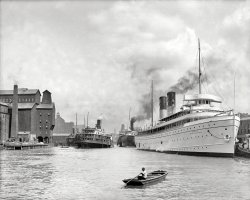
- Swing Shift: 1943
- April 1943. Buffalo, New York. "Swing-shift workers on the sidelines at the weekly swingshift dance held ... Posted by Dave - 09/15/2017 - 4:19pm -
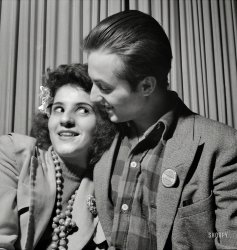
- Shady Saratoga: 1915
- Saratoga Springs, New York, circa 1915. "Broadway at the United States Hotel." Looking more than a ... Posted by Dave - 08/14/2018 - 10:40am -
![Shady Saratoga: 1915 Saratoga Springs, New York, circa 1915. "Broadway at the United States Hotel." Looking more than a little like one of those idealized Disney "Main Streets." 5x7 inch dry plate glass negative, Detroit Publishing Company. View full size.
Everything I loveThis photo in particular just struck me and it has all the elements that keep bringing me back to Shorpy every day.
I love the wonderful buildings, horse drawn carriages, early automobiles and well-dressed folks strolling down the sidewalk under stately trees. It could not get much more picturesque.
It is a time and place I would trade almost anything for to see with my own eyes.
But I am glad there are photos and that we have Shorpy, Dave and the other members sharing them with us. Keep up the great work!
Main Street USAIt's interesting to note that when Walt Disney was creating Disneyland, his relationship to the historic period portrayed in his Main Street (approx. 50 years past) would be like ours to the 1950s and 60s.
Street lights!I just noticed those wonderful street lights, that look like a little girl holding balloons. Disneyland needs to reproduce those right now!
Lewis Hine AlertNewsies at the center. Of course, something tells me that being a newsboy in Saratoga Springs probably wasn't as bad as doing the same job in, let's say, Buffalo or NYC.
Yet another awesome image for the colorizers out there!
TodayI'll venture a guess that this street view today has virtually nothing remaining from 97 years ago, especially the trees! Can anybody provide a modern view?
View Larger Map
At the racesA timely photo, as this year's Saratoga race meeting starts in a few days. Some winners of the prestigious stakes from 1915:
Alabama Stakes: Waterblossom
Hopeful Stakes: Dominant
Sanford Stakes: Bulse
Spinaway Stakes: Jacoby
Travers Stakes: Lady Rotha (A filly in a race usually dominated by males)
I dabble in racing history, and have never heard of any of these horses. 1915 was a pretty lame year at the Spa!
SpectacularWhat a glorious image; visual poetry. It is filled with so many priceless details. We have lost so much....
It would be an epic job but I hope that someone will please colorize this one.
Majestic ElmsWhat strikes me most about this photo and hardly seen in present day are the elms that line the street. Such a sad thing and unique thing to have left us.
Quite a bit remainsThey've done a great job of keeping this vantage particularly pretty much the same. There's been some fires and other changes but the "Adelphi" is still there and open (only in the summer). It's worth a visit for a cocktail in the garden. 1906 & today:
Great American Main StreetMy apologies to "History Lover", but I do not have a photo of Saratoga's current Broadway to share. However, I can state that a great majority of what is visible in the photo does, in fact, still remain. Yes, much has changed and the Elms succumbed to disease many years ago, but it is a vibrant and rich downtown. Travel and Leisure named it as "One of America's Greatest Main Streets" and the National Trust for Historic Preservation awarded it one of five "Great American Main Street" awards. The United States Hotel opened in 1874 and had 768 rooms and 65 suites. It was, however, surpassed in size by the Grand Union Hotel, which in its day was the largest hotel in the world, covering some seven acres. "Lost World" is right - opening day for Saratoga's 144th year of thoroughbred racing commences on Friday, July 20th!
Lots of kids, butLove, love, LOVE this image, but where are the babies? The baby carriages? So many people and no little ones?
[These are vacationing wealthy people. The babies would be with their nannies. - tterrace]
Looks the same to meThe Saratoga Planning Departments should be commended. It still has amazing charm. These were taken in 2010.
(The Gallery, DPC, Saratoga Springs)](https://www.shorpy.com/files/images/SHORPY_4a27640a.thumbnail.jpg)
- Television Screen: 1950
- July 12, 1950. "Hilda Kassell, East 53rd Street, New York City. Father reading newspaper, two children viewing television." The ... Posted by Dave - 09/16/2013 - 9:26am -
![Television Screen: 1950 July 12, 1950. "Hilda Kassell, East 53rd Street, New York City. Father reading newspaper, two children viewing television." The test-pattern tone is especially hypnotic this morning. Photo by Gottscho-Schleisner. View full size.
Multiple photosOther Gottscho-Schleisner photos relating to Hilda Kassell can be found online. There's one from about this same time showing her nursing her baby in front of this window, one from 1948 of what I would presume was her former residence at 50 East 10th Street, and an undated interior view of what may be her country house in Croton, New York. As there also are some references to photos by her, my best guess is that she worked for Gottscho-Schleisner or at least was associated with the company in some way. Hence their interest in her domestic life.
[Hilda Kassell was the designer whose business commissioned these photos. The people in them are models; the grander homes are those of her clients. -Dave]
Test Pattern IndianWe got our first TV in 1951 when I was 3 or 4 years old. I remember spending a lot of time staring at the Test Pattern Indian, and even at that early age wondering what the hell an Indian was doing in our TV, and when was he going to DO something. Maybe I really WAS hypnotized by the tone.
I Would Title This "Waiting for Howdy Doody"
It's all relativeCompared to nothing-zip-nada, a test pattern was interesting, if only because it indicated that the set was ready to erupt into entertainment when programming began (usually, late afternoon). And it was our technological friend, enabling the painstaking setting of horizontal and vertical hold, contrast, brightness, and whatever quality brings about absence of "snow," all before Buffalo Bob and Howdy appeared.
Did everyonehave a ship and brass baby shoes on top of the TV in the early 50's? I know we did.
Good QuestionWonder why the Indian head shot was used. It seems fairly universal, but why?
[A story about the original artwork and its survival is here. -tterrace]
Thanks, wonder why the fellow in '38 made that choice. Just because? Line definition quality? Thanks again.
Attention SpanAnd so it begins. The dumbing down of our children.
There really is nothing on TVIn this case, not only are the kids staring at a test pattern, they're staring at a fuzzy test pattern. At first I thought this was because WJZ is a Baltimore station, but in 1950, it was the ABC flagship station in New York.
Blank StaresThere's nothing quite like pretending to read the morning paper while the kids pretend to watch TV.
$419.95Looks like a Zenith, Lexington model without cabinet doors. Cost is four weeks pay for the average factory worker in 1950.
[It's an Olympic. -tterrace]
Olympic Radio & Televisionwas a trademark of Hamilton Radio Corp., established NYC 1941. Hamilton purchased the Olympic trademark from American Bosch Radio the same year. In 1956 Olympic Radio & Television was still operating as a division of Unitronics Corp. of Long Island City. It probably disappeared the following year when Unitronics was absorbed by Siegler, which then merged with Lear Inc.
Step UpOlympic was a recognized radio brand in the 1960s. Its TV line was strictly promotional. The attached ad shows a Radio/TV/Phono combo that probably sold in the $300-$400 price range. A comparable Magnavox unit sold for 2 to 3 times as much.
Sitting that CloseI was a child in the late 1960s. Whenever I would watch television my parents always supervised me because they wanted to ensure that I didn't sit too close to the set. They were convinced sitting too close to the television would cause me to develope leukemia or it would ruin my eyesight.
The first thought I had, when I looked at this photograph was the sound of my mother's voice "Don't sit so close to the TV!"
By the time I was 16 years old, I did have to start wearing glasses which gave my parents an "I told you so." moment. They were convinced that my lazy eye was a result of sitting too close to the tv when I watched Captain Kangaroo as a four year old.
The Ultimate Home Theatre!It's got both a small screen AND a big screen (for Dad to hide behind)!
Subway foldDad - or the model playing dad - is probably a regular subway rider. That's the NY subway fold that I learned from my father. When you're on a crowded train, there isn't room to open the paper all the way. So you fold the pages in half lengthwise.
PatternI hated daytime TV in the '50s. You'd be home sick from school and all that was on would be soaps and Queen for a Day.
You'd be lying there bored to death with onions that your Mom put in your socks, I have no idea what they were supposed to cure but Mom must have known.
(The Gallery, Gottscho-Schleisner, Kids, NYC, TV)](https://www.shorpy.com/files/images/SHORPY_5a19812u.thumbnail.jpg)
- Flatcar Follies: 1920
- ... with a buffalo in between, as the company was located in Buffalo, NY. The article below notes the company's connection with the NY ... foundry business of the East Buffalo Iron Works, on the New York Central Belt Line, near Broadway. In 1869 Knight left the company at ... Posted by Dave - 05/21/2018 - 11:40am -
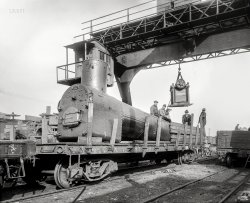
- Postal Bestiary: 1905
- Buffalo, New York, circa 1905. "Post Office on Ellicott Street." Note the numerous ... Posted by Dave - 07/22/2020 - 4:03pm -
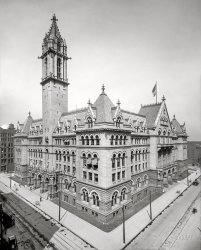
- Savannah: 1905
- ... "Ocean Steamship Co's Docks, Savannah, Ga." from the New York Public Library Collection.
The faded message is dated March 30, ... but the end is really nasty like using the grain legs in Buffalo, NY.
I can't decide if I like the ships more or the mishmash of ... Posted by Dave - 08/09/2012 - 1:19pm -
![Savannah: 1905 Circa 1905. "The docks at Savannah." 8x10 inch dry plate glass negative, Detroit Publishing Company. View full size.
Is something amiss?Looks like there has been a derailment in the middle of the street.
FinallyA Pepsi-Cola sign.
Interesting shipCabins all around, but the way it is riding high in the water it seems to wait for bulk cargo as well. I wonder what it was and how it got stowed on board. No big conspicuous cargo hatches I could see.
Re: Interesting shipI posted a link to the photo on the Southern Railway Historical Society Yahoo group, and one of the members, Bob Hanson, a resident of Georgia, posted the following comment:
"The ship on the left taking coal appears to be either the City of Atlanta or the second City of Columbus (sister ships) of the Ocean Steamship Company of Savannah, a subsidiary of the Central of Georgia Railway."
Steam and Sail.Looks like the need to get that coal onboard to stop the listing to port! Not too much cargo goes on board this ship, only one noticeable cargo hatch forward towards the bow and only one crane to service it. And yes this ship does have sails as well. You can see a furled sail on the aft mast. Back in those days sails were breakdown insurance and used to help supplement steam power.
Savannah Docks, Detroit's finished productA 1904 postcard from the Detroit Photographic Company, titled, "Ocean Steamship Co's Docks, Savannah, Ga." from the New York Public Library Collection.
The faded message is dated March 30, 1906, and reads:
"Margaret & Irene, Arrived here this morning, we had a fine trip, been doing Savannah all day. We found it a lovely place and the weather like July in New York. Oh, it is just lovely. We take train to Atlanta tonight. Marie & John"
Potential Disaster In Savannah?I should have gone into a little more detail in my earlier comment. I really wish that smoke/steam was not obscuring the view of the locomotive as much as it is.
The tender appears to have derailed in the middle of the street. It looks as though it might have become detached from the engine. If so, and the water supply to the engine was interrupted, then everybody in the area should be running for their lives. I've posted some photos to my Flickr site of a 1948 boiler explosion that illustrates what happens when a steam locomotive runs out of water while the firebox is hot:
www.flickr.com/photos/michaeljy/3514234654
Also, notice that something has happened to the boxcar on the left side of the street, causing its load to shift and push its door out at the bottom. It looks like it might be loaded with bales of cotton. This poses a great dilemma for the railroad, since the door is barely hanging on and could fall off at any time. Those things are heavy. The car is half blocking the street, and it can only be moved with the greatest care, perhaps it can't be moved at all until the problem is fixed.
Meanwhile, all of this has blocked the rail access to this entire area, meaning that until these problems are solved, these extremely busy docks cannot be serviced.
Sleek That passenger/packet freighter sure has the sleek lines of that time. I like that architecture! It must have taken a long time to shovel all that coal from the barges into the bunkers of the ship.
[Coaling was accomplished with a mechanical conveyor, seen here in its raised position. - Dave]
I didn't notice the conveyer. That will speed things up a lot but the end is really nasty like using the grain legs in Buffalo, NY.
I can't decide if I like the ships more or the mishmash of rooflines in this photo!
Coaling at SavannahAs one always interested in the early 20th century coal economy (e.g. Berwind's Eureka Coal), any chance for an application of ShorpyZoom™ on the coal barges in this photo?
Gone To HistoryI tried finding this location, but the port of Savannah has changed so much that it is impossible. This area is likely under where the Talmadge Bridge now is.
Re: Coaling at SavannahWhat a dirty and labor-intensive job that was! Looks like there might be as many as a dozen or so men on that barge next to the ship, including one at the bottom of the ladder. There is no sign of any motorized vessel in the area, so I guess they had to use a combination of wenches and lines from the ship, along with sheer manpower, to maneuver the barges around as they were emptied.
The mechanical bucket, scuttle, collier, or whatever it was called, looks as though it had to be filled manually in the barge (as opposed to a clamshell-type contraption). Even with that many hands working, moving that much coal had to be a back-breaking task. But I guess people back then were accustomed to such.
[If any wenches were used, it wasn't for coaling. - Dave]
Steady as she goesThe sails on the ship to the left were probably only used as a staysail to stop the boat from badly rolling in swells, as there seems to be lots of rigging and substantial shrouds to get in the way of efficiently using wind power as a backup if the engine conked out -- you wouldn't want all your passengers too seasick.
The Cadsbyis the vessel in the center of the picture opposite the liner in the foreground. In the Cadsby photo, the vessel seen in the background may be the same as in the original, not sure.
(The Gallery, Boats & Bridges, DPC, Railroads, Savannah)](https://www.shorpy.com/files/images/SHORPY_4a10456a1.thumbnail.jpg)
- Garbage In: 1943
- ... widow, is crane operator at Pratt & Letchworth, Buffalo, New York." Photo by Marjory Collins, Office of War Information. View full ... Posted by Dave - 09/13/2017 - 8:44am -
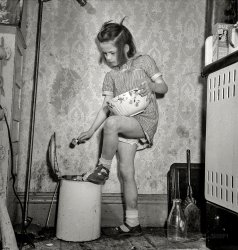
- Bill Mack: 1908
- Buffalo, New York, circa 1908. "Unloading ore from Hulett machine." 8x10 inch dry plate ... Posted by Dave - 11/23/2013 - 11:40am -
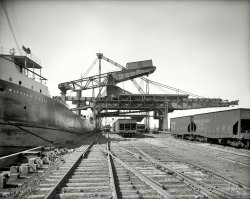
- Orchard Park: 1943
- May 1943. "Buffalo, New York. Peter Grimm, age 10 (last seen here ), delivers for Loblaw's grocery ... Posted by Dave - 09/08/2016 - 10:27pm -
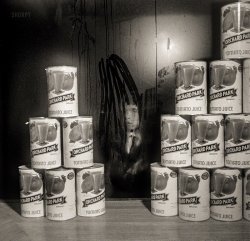
- Bedded Wheat: 1906
- Niagara Falls, New York, circa 1906. "Natural Food Conservatory. The whole wheat cleaned and ready ... Stops Here As I recall from my school days in suburban Buffalo, it was milling that made Buffalo a "big" city. Grain could easily be ... Posted by Dave - 08/20/2012 - 11:06am -
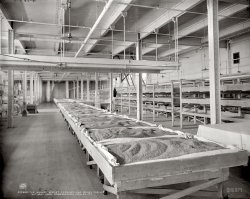
- Tifft House: 1900
- Buffalo, New York, circa 1900. "Tifft House, Main Street." Demolished 1902; home to ... Posted by Dave - 07/17/2016 - 1:08pm -
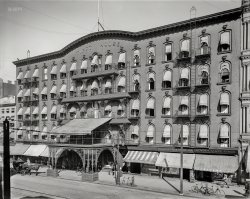
- Corner Pocket: 1918
- June 22, 1918, in or near New York City. "Miss May Schloss at canteen." 5x7 glass negative, George Grantham ... was the infantry). - Dave]
Mrs. Salsbury From the New York Times, July 27, 1919:
"Miss May Schloss, daughter of Mr. and Mrs. ... Posted by Dave - 11/15/2008 - 2:44am -
![Corner Pocket: 1918 June 22, 1918, in or near New York City. "Miss May Schloss at canteen." 5x7 glass negative, George Grantham Bain Collection. View full size.
The Hustleress"I'm really not very good... my brothers tried to teach me... I just knock the balls around most of the time... Oh, a bet? You mean for money? Oh I don't think so... well, I guess we could..."
She's played the game beforeHer left-hand's held in a pretty good bridge, she's down over her cue. I'd say she knows what she's doing. They're obviously not playing eight-ball. Could be some form of rotation since only the high balls are left on the table, or maybe straight pool.
The Original GumpThat would be a rendering of Andy Gump on the blackboard.
http://lambiek.net/artists/s/smith_sidney.htm
Navy has better tailors.Navy was better dressed than Army in 1918, too. Some things are constant through the ages.
Chalk TalkSay, anyone have a clue what's the last word above those cartoon military guys..."Before the Black S...."? Must have something with the 10 days bread and water, but I couldn't figure it out.
["Before the black slave" (there was the infantry). - Dave]
Mrs. SalsburyFrom the New York Times, July 27, 1919:
"Miss May Schloss, daughter of Mr. and Mrs. Henry W. Schloss of 156 West Seventy-fifth Street, who has been prominent in war camp community work in New York, will be married to Nate Salsbury of Chicago on Aug. 2, at the home of her parents, the Rev. Dr. Mussey of the Ethical Culture Society to officiate. Mrs. William H. Schloss, a sister-in-law of the bride-elect, is to be her only attendant. Captain Milton Salsbury is to act as best man for his brother. Mr. Salsbury is connected with Marshall Field in Chicago, where the couple are to reside."
Sharkbite!Is that thumb legal?
Nate Jr. and MiltonWere the sons of Nate Salsbury, owner and manager of Buffalo Bill's Wild West Show. In a matter of minutes I found a photo of Nate Jr and Milton as infants and other photos of their Dad with the stars of the Wild West Show. (Gotta love the Internet!)
New York Times, May 10, 1924, pg 21: "Dissolution Notice": "The co-partnership of Freedman-Salsbury Co., composed of Benjamin H Freedman and Milton S. Salsbury, and also doing business as the Herkules Saw Sales Co. of America with address at 233 Broadway, New York City, has been dissolved." - Milton S Salsbury (Milton Salsbury was the son of Buffalo Bills manager Nathan "Nate" Salsbury.)
Another interesting note -- This Benjamin Freedman tried to blackmail Woodrow Wilson.
Who knew a kooky photo of people playing pool would yield
so much?
(The Gallery, G.G. Bain, WWI)](https://www.shorpy.com/files/images/27137u.thumbnail.jpg)
- Great Northern: 1900
- Buffalo, New York, circa 1900. "Great Northern elevator and shipping." The freighters ... Posted by Dave - 09/28/2017 - 3:02pm -
![Great Northern: 1900 Buffalo, New York, circa 1900. "Great Northern elevator and shipping." The freighters Andaste of Ishpeming, I.W. Nicholas and B.L. Pennington. 8x10 inch dry plate glass negative, Detroit Publishing Company. View full size.
Whaleback!Nice photo. Vessel on the left looks like a whaleback, and unusual Great Lakes type of freighter.
[Click the link in the caption. —Dave]
Schooner barge PenningtonHere's some history and a photograph of her under tow.
Schooner or Schooner Barge?B.L. Pennington is rigged as a 3-masted schooner but the rig looks somewhat small for the size of the ship. No sails, booms, or gaffs are in evidence, but there's a funnel, forward of the foremast. It's too small to feed a propulsion engine and in the wrong part of the ship so I think it's a "Donkey boiler" driving auxiliary systems. These were common on oceangoing sailing ships of the period as a means of reducing crew size and cost by doing some of the heavy work like hoisting sails and anchors.
Hull form is bluff and quite ugly -- I doubt this ship could move much under sail, which brings up the possibility that it could be a "Schooner barge" designed to be towed most of the time by a tug, using sail as an auxiliary power source to save fuel in favorable conditions. This was a common arrangement on the East Coast but dates to a slightly later period there. I'm not sure if it was used on the Lakes at all.
Chapelle's "American Sailing Ships" does not have a specific chapter on the Lakes but he does include a few sentences on Great Lakes schooners in the schooner chapter. This discussion is too short and general to help much in this case; it says Lakes schooners rarely had masts all the same size but could have up to 5 masts. It is hard to imagine Pennington coming all the way up the St. Lawrence and through the locks, even with a tug helping.
(The Gallery, Boats & Bridges, Buffalo NY, DPC)](https://www.shorpy.com/files/images/SHORPY-4a08420a.thumbnail.jpg)
- Heavy Lifting: 1908
- Buffalo, New York, circa 1908. "Brown electric hoist unloading ore carrier." 8x10 inch dry ... Posted by Dave - 07/22/2012 - 10:40am -
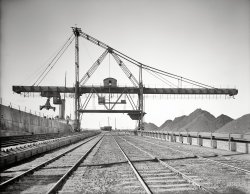
- They Drive by Night: 1949
- ... Mary (1947, by Norman Krasna) at the Strand Theatre in New York in February of 1949. Carson was also in the film version (1949) starring ... Posted by Dave - 06/24/2015 - 10:13pm -
![They Drive by Night: 1949 Chicago, 1949. "Theater traffic on State Street." 35mm negative by Stanley Kubrick, on the outside looking in, for Look magazine. View full size.
John Loves MaryThe same cast of Jack Carson, Marion Hutton and Robert Alda performed in the play John Loves Mary (1947, by Norman Krasna) at the Strand Theatre in New York in February of 1949. Carson was also in the film version (1949) starring Ronald Reagan and Patricia Neal. The Chicago Theatre was built in 1921, is seven stories tall, fills half a city block, and seats 3,600.
That Toddlin' TownWow, this is just how I remember 1950s Chicago! When our family took the train from Buffalo to St. Paul, we had dinner at some fancy Chicago restaurant. It truly was a Toddling Town to this 5-year-old Upstate New York Country Girl!
Shorpy was hereKubrick's photo is from the same vantage as an earlier Shorpy photo from 1907.
Stanley Kubrick?Is this the same "Stanley Kubrick" that directed movies like "2001: a space Odyssey" and "Full Metal Jacket"?
This does show that 35mm film can produce a wonderful nighttime image.
[Yes, that Kubrick. And an early example of the "Kubrick perspective." -tterrace]
State Lake gonebut the Chicago remains.
Cherry Picker Shot?Kubrick's camera appears to be about 25 feet off the ground for this shot. How did he get the camera up that high? Maybe a cherry picker? Or, maybe a sturdy tripod with a vertical extension shaft?
[This way. -tterrace]
Savage! Searing! True!He Walked By Night (1948), B & W film noir, with Richard (Voyage to the Bottom of the Sea) Basehart. Jack Webb was also in this film, and a friendship he formed with a police technical advisor led to the creation of Dragnet.
Greyhound StationGreyhound buses linked up on the right. My Chicago expert (and wife) points out that the Greyhound bus station is to the right around the next corner on Randolph St.
Tech Specs?Anybody care to venture a guess on Stanley's camera/film settings here? There's a blurred car in the center, and blurred people under the theater entrance. What would have been 'typical' pro camera settings then?
State-Lake Theatre still around, sort ofThe building's still there, but unfortunately the interior was gutted in the mid-late 80s and turned into the studio and offices for the local ABC TV station.
(The Gallery, Cars, Trucks, Buses, Chicago, LOOK, Stanley Kubrick)](https://www.shorpy.com/files/images/SHORPY-07255u.thumbnail.jpg)
- Deadeye Dick: 1910
- Student at vocational school in Buffalo, New York. February 1910. View full size. Photograph by Lewis Wickes Hine.
... Posted by Dave - 09/07/2011 - 9:24pm -
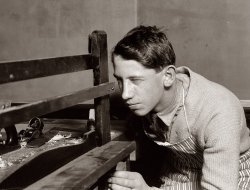
- Howdy Duty: 1953
- ... but that's a tad unlikely in June (I KNOW it's not western New York, after all).
[It's a thing called an automobile. - Dave]
... Posted by Dave - 01/27/2019 - 2:33pm -
![Howdy Duty: 1953 June 1953. "Clarabell takes to the hills. Howdy Doody Show character Clarabell the Clown (actor Nick Nicholson) visiting the Dolan family in Boone County, West Virginia." Photo by Phillip Harrington for Look magazine. View full size.
Please help meI think that I'm seeing things. What is that thing out the screen door? It almost looks like a snow blower, but that's a tad unlikely in June (I KNOW it's not western New York, after all).
[It's a thing called an automobile. - Dave]
CreepyI am not anti-Clown, but wow-w
Those were the daysChief Thunder Thud, Princess Summer-Fall-Winter-Spring, Phineas T. Bluster, Buffalo Bob Smith, the Peanut Gallery.
Nice clownPhotos of clowns usually bring out the observations about how scary and creepy they can be, but this particular clown actually has a gentle and sympathetic look on his face. Maybe it’s the furrows in his brow, maybe the sad eyes, but I’m not afraid of him.
Bob Sandwich Bob's Sandwiches would make more sense, but it does indeed say Bob Sandwich Try one today.
Maybe it refers to Buffalo Bob or something on the show?
Inadequate Inflation - Long Bob Sandwich?I am going to guess the balloon refers to the famous Long Bob Sandwich from Bob Phillips Drive-In. The drive-in was just north of Boone County in the Kanawha City part of south Charleston. The drive-in opened in 1952.
Jerry Waters has a site with some photos of this fine establishment: http://www.mywvhome.com/fifties/phillips.htm
BOB SANDWICHDo I see an imprint on one balloon? Can't tell if local delicacy or politician or goodness knows what. I'll take a wild guess that fine print is "Try One Today," but that's wishful thinking. Ideas, anyone?
Mute ClownClarabell never spoke until the last episode of Howdy Doody, when he said with a tear in his eye: "Bye, kids!"
Sung to the tune of "Mademoiselle from Armentières".Who's the funniest clown we know?
Clarabell!
Who's the clown on Howdy's show?
Clarabell!
His feet are big, his tummy's stout,
But we could never do without,
Clara, Clara, Clarabell!
Who has fuzzy-wuzzy hair?
Clarabell!
It's partly red but mostly bare.
Clarabell!
And since the day that he was born,
He's honked and honked and honked his horn.
Clara, Clara, Clarabell!
(Kids, LOOK, TV)](https://www.shorpy.com/files/images/SHORPY-11431u.thumbnail.jpg)
- Franklin Gothic: 1919
- ... the Memories! A friend of my dad's, Mr. Bill Gewand of Buffalo, New York, had a copy of this car back in the late 1950s. As the old saw goes, ... Posted by Dave - 02/16/2016 - 6:29pm -
![Franklin Gothic: 1919 San Francisco circa 1919. "Franklin Brougham." A car with an air-cooled engine and unusual veed windshield. Latest entry in the Shorpy Catalog of Quirky Conveyances. 5x7 glass negative by Christopher Helin. View full size.
Replica ResidenceThe noble home in the background is at 3800 Washington Street in San Francisco. It was built in 1904 as an homage/knockoff of the Petit Trianon on the grounds of the Palace of Versailles in France.
According to zillow.com, there's currently an offer on it for a cool $18 million (give or take a few sous).
Sugar Daddy's House[An impressive edifice, but it's obviously not Spreckels Mansion. - Dave]
Duh! My bad. I spent 30+ minutes on Street View and Images trying to pin it down w/o success.
Unusual in many waysProbably the most unusual thing about the early Franklins is they used a Wooden frame up to about 1928.
[Many, if not most, autos of the era used wooden frames. - Dave]
Thanks for the Memories!A friend of my dad's, Mr. Bill Gewand of Buffalo, New York, had a copy of this car back in the late 1950s. As the old saw goes, he found it in a barn where the farmer was using it as a chicken coupe, although in this case it was true. It took a lot of TLC, but he got the car looking almost as good as the one in this photo and running like a dream. Your picture brought back happy memories, thank you very much.
["Chicken coupe;" haha, very good. -tterrace]
Thug Mansion3800 Washington was also occupied by a squatter for months recently.
YIPPEE!!!!!!My styling favorite car EVER! Besides a lot of unusual standard features like wooden frame and air-cooled engine, the V or "veed" windshield was a Franklin trait up through the mid-20's; available on their closed cars. It doesn't show well in this photo but if you could see a photo of this dream car from the front, it looks like a spaceship. Too cool; thank you, thank you, thank you!
Design Of The FutureAerodynamic Windpusher.
Wooden It Be NiceThough the Franklin was known for having a wooden chassis, few, if any, major auto manufacturers used them.
[Not so, as owners of brass-era and later cars will attest. Maurice Hendry, in "Cadillac: Standard of the World," recalls an anecdote in which an ash-framed Cadillac chassis proved more resistant to being twisted apart than a steel frame. Below, an excerpt from "Making and Selling Cars: Innovation and Change in the U.S. Automotive Industry." - Dave]
Though I am in no position to argue with a man like Mr. Hendry, he is wrong. Every Model T ford ever built had a steel frame. So did every Dodge, every Durant product, every Maxwell, every Sudebaker (after they went to gasoline powered cars). Pierce, Pope, Stanley, Thomas, Stoddard Dayton, Alco, Locomobile, White, just to name a very few used steel frames. As to Mr. Hendry's assertion that Cadillac used a wooden frame, here is an excerpt from The History of Cadillac.
"The 1903 chassis had angle steel frame with two half-elliptic springs front and rear with straight, tubular front axle. The steering wheel was located on the right-hand side with the controls to the right and using adjustable rack and pinion steering gear. The single tube tires were mounted on 56 cm wood wheels with 12 spokes (14 on the prototype)."
Every Cadillac, ever built, had a steel frame
Wood it, or notCould be that the wood "frame" referred to in some places is the wood that "framed" the body of the cars, and not constituted the chassis' structure. Fisher Body ( read GM) didn't cease wooden framed construction until the mid 1930s. Custom built cars, and low production ones lasted even longer.
Re Wooden It Be NiceIs it possible that the word "frame" is being used in different ways? Certainly the Model T and Model A had a great deal of wood in the "frame" that supported the body panels. This was true of many other cars, and is still true of Morgans (the last time I looked). While I don't know of any that used wood for the "chassis" (another ambiguous word) that supports the axles, driveshaft, etc, I wouldn't be terribly surprised if some early ones did so. Here's a link to diagrams of the "body frame" wood for Ts and As:
http://fordwood.com/
(The Gallery, Cars, Trucks, Buses, Chris Helin, San Francisco)](https://www.shorpy.com/files/images/SHORPY-896.thumbnail.jpg)
- Visitors Welcome: 1906
- Niagara Falls, New York, circa 1906. "Entrance, Natural Food Conservatory." Breakfast food pioneer ... Posted by Dave - 08/14/2012 - 10:47am -
![Visitors Welcome: 1906 Niagara Falls, New York, circa 1906. "Entrance, Natural Food Conservatory." Breakfast food pioneer Henry Perky's Shredded Wheat factory, a.k.a. "The Palace of Light," was a popular tourist attraction. Bring your appetite, and watch your step. 8x10 inch dry plate glass negative, Detroit Publishing Co. View full size.
They took paradise and put up a parking lot.The "Palace of Light" Shredded Wheat factory was apparently on the north side of the 400 block of Buffalo Avenue in Niagara Falls with a nice unobstructed view of the rapids near the falls.
The site is now a vacant lot with a nice view of the Ramada Inn between it and the rapids.
"The beautiful structure of The Natural Food Company is located on Buffalo Avenue (occupying ten acres), in the finest residence portion of the city, with a frontage of 900 feet on the Niagara Rapids."
Don't look up!I said DON'T look up, there's a guy in the window on the right watching us. Just act cool.
50,000 Vistors Annually!
"V"Why is "Natural" spelled with a "V"? Odd.
[Classicists will recognize that as a Latin (or Roman) U. - Dave]
Creepy, but at least there is a place for your bike...I've noticed people frequently commenting on the lack of bike racks in most of these photos, despite the abundance of bicycles.
Well, this place appears to have two!
Unfortunately, at least in this photo, it also looks like you might not need to secure your bike. After all, you won't be seeing it, or the light of day, again.
The uniforms look likeThey came from West Point, what the cadets wear.
Deveaux studentsMy wife grew up across the street from this building. Her brother attended Deveaux School and according to her the uniforms are identical to what the Deveaux students wore. The brother attend the prep school on a scholarship because their father was serving in WWII. The Deveaux school said the school was preparatory for entry into West Point, but few students actually became West Point Cadets.
(The Gallery, DPC, Factories)](https://www.shorpy.com/files/images/4a11844a.thumbnail.jpg)
- GLEW: 1906
- ... freight trade between Buffalo and Lake Superior. The new owners already operate several boats in general.
Depressing This ... insurance on the S. J. Christian was collected in New York it seems.
... Posted by Dave - 08/14/2012 - 2:11pm -
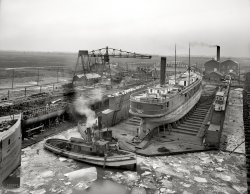
- Spud Noel: 1925
- ... today by Maj. F.C. Fegley, who arrived here yesterday from Buffalo, N.Y., for that purpose. A large building was leased at 22 R street ... by tomorrow, some coming from the main headquarters in New York city.
The Volunteers of America is an offshoot of the Salvation ... Posted by Dave - 08/13/2012 - 6:09pm -
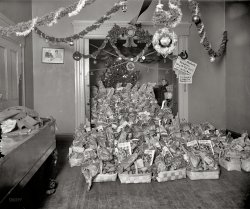
- The Motor Fire Engine: 1913
- "Under the hood of the motor fire engine" with the New York Fire Department circa 1913. View full size. 5x7 glass negative, George ... Posted by Dave - 09/08/2011 - 11:57am -
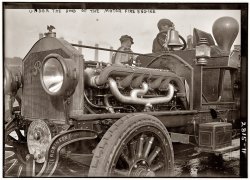
- This Old New House: 1900
- From around 1900 we bring you someone's new house in the vicinity of Stafford, Connecticut. Fancy millwork abounds! 5x8 ... in Lake View, New York (about twenty-thirty miles south of Buffalo, NY) cited in the advertisement is still standing and happily occupied ... Posted by Dave - 03/03/2016 - 4:33pm -
![This Old New House: 1900 From around 1900 we bring you someone's new house in the vicinity of Stafford, Connecticut. Fancy millwork abounds! 5x8 glass negative. View full size.
That is a beautiful home... but it looks to me like the owner should invest in a lawn mower.
[He's on his way to pick up a scythe at Home Depot. - Dave]
Beautiful house, butMy first reaction was, "Wow, would I hate to have to paint that baby!"
Gingerbread Kit? Looks like the sort of house you could order from the Sears catalog:
Lawn CareOr they could be out getting a couple of goats.
It Never Rains in Connecticut!So no need for gutters or downspouts.
First, Second, and Third Reaction, and CountingIn my last neighborhood of some 25 years, I had a neighbor who had one of those 3-story Victorian things all covered in gingerbread. When I first moved there, the house was merely 2-color. About ten years later, the neighborhood was zoned "historic" and the local "hysterical commission" ruled that all renovations should be rigidly return to originality. Painting thereafter included a process of paintchip lab analysis to determine original colors. So I watched my neighbor tediously paint that gingerbread behemoth in seven colors, much of it on countless lathe-turned bits. Sure, it was pretty when it was all done, but....It made me absolutely love my slightly moldy brick.
My first thought (and my mother's as well) on the current acreage with grass like that was "goats", but I've learned to simply appreciate the sight of grass just like that in the home shown here--it's positively lovely to watch ripple like waves on a pond on a breezy day, while providing a habitat for countless butterflies by day and fireflies in the millions by night. One of my neighbors does goats, while another does llamas.
Re: Gingerbread kitThe kit home in Lake View, New York (about twenty-thirty miles south of Buffalo, NY) cited in the advertisement is still standing and happily occupied to this day. Those homes, while being kit homes, were built to last!
IlluminatingI'm intrigued by the lamppost, which looks very modern!
The Handsome Gas LampNote that the lamppost has two crossbars near the bottom and one just below the lamp. This is almost certainly a gas lamp. The crossbars at the bottom are steps for the lamplighter, and the one at the top is a hand-hold or ladder rest.
Also note the lack of any signs of electrical service to the house.
[Also note the lamppost stops before it gets to the lamp. This is a kerosene fixture with a burner on top. - Dave]
(The Gallery, Small Towns)](https://www.shorpy.com/files/images/SHORPY-912A.thumbnail.jpg)
- Double Truck: 1941
- ... 1941. "Car transport filling up with gas at Little Falls, New York." Medium format negative by John Collier. View full size.
What ... hood ornament is visible.
Eastern Auto Forwarding of Buffalo, New York had orange trucks with green lettering. Their motto was ... Posted by Dave - 11/12/2017 - 2:07pm -
![Double Truck: 1941 October 1941. "Car transport filling up with gas at Little Falls, New York." Medium format negative by John Collier. View full size.
What make ?Is this a GMC cab over?
[Dodge. -tterrace]
There's one hidingI've never seen one like this either but I found a pic of a similar setup with open sides.
Chevy hidden insideToo much Dodge on the outside for it to handle.
The Sticker on the TruckI remember seeing trucks with that sticker having an "M" inside the shape of the US. Does anyone know what that signifies?
"M" Is For MarkelThe sticker on the truck that "Vonderbees" asked about is from Markel Service, Inc. Markel insured buses and trucks starting in 1930, and it was also involved in promoting safety and standards for drivers. The firm also helped to pass the National Motor Carrier Act of 1935. The firm exists today as Markel Corporation, and it is a Fortune 500 company.
As a part of their program to promote safety, drivers were given safety awards for each year that they did not have an accident. A variety of these awards and award certificates is shown below. The pin with number "1" in the red diamond is believed to be an early award as few of these are known to exist. Awards in the style of the 4-year pin shown seems to have followed, but these were likely awarded for only a short period of time as these are also very hard to find. Pins in the style of the 15-year award shown were issued into the 1950s, and the 20-year award was the last style issued.
The other side of the Dodge truck is seen in the photo below. The truck is from 1940, and this was the first year that the Dodge cab-over truck body was entirely designed, engineered, and built in-house. The previous three years the body was manufactured by Montpelier Company of Montpelier, Ohio. The 1940 models are easily identified by the lack of cowl lights which were on the 1941 and 1942 models. In this initial year of production 1 1/2 ton and 2 ton models were available. The cab could seat three, and it was up high enough that the floor of the cab was flat. The directional (turn) signal lights are mounted on the fender tops, and a Dodge ram hood ornament is visible.
Eastern Auto Forwarding of Buffalo, New York had orange trucks with green lettering. Their motto was "Dependable As The Rising Sun." They once had a fleet of 385 rigs, but by 1964 this was reduced to 50 as the railroads became a more efficient means to transport new vehicles. The firm was bought out by Buffalo based M&G Convoy in 1964.
Markel SpottingThere's at least one more truck with the Markel symbol on Shorpy. See it here.
(The Gallery, Cars, Trucks, Buses, Gas Stations, John Collier)](https://www.shorpy.com/files/images/SHORPY-8c33337a1.thumbnail.jpg)
- Stop Bryan-Kern: 1908
- Niagara Falls, New York, in 1908. "Niagara Street." Presided over by a banner advertising the ... Posted by Dave - 08/21/2012 - 1:22pm -
